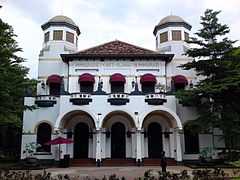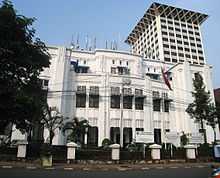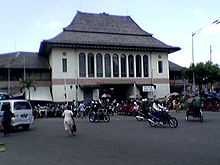New Indies Style

New Indies Style (from Dutch Nieuwe Indische Bouwstijl) is an architectural term for modern architectural movement that appeared in the Dutch East Indies (now Indonesia) between the brief period of late 19th-century to pre-World War II 20th-century. The term is loosely applied to any early modern architectural movement (e.g. Rationalism, Art Deco, etc.) that make use of local architectural element - such as wide eaves or prominent roof - as an attempt to conform with the tropical climate of Indonesia.[1] Even though New Indies Style refers specifically to Dutch Rationalism movement that appear in 1910s Indonesia, for the purpose of covering the many architectural styles that appear during the brief early modern period, the term is used as a general term for all the architectural styles that appear between the late 19th-century to pre-World War II 20th-century.
History
The attempt to synthesize Dutch architecture with Indonesian local architecture had already started since the 18th-century. Heavy maintenance of the 17th-century Dutch-style buildings in the tropics had forced the Dutch to follow examples from indigenous architecture of Indonesia. The attempt first appears in the Dutch Indies country houses of the 18th and 19th-century, a style academically known as Indo-European (Indo-Europese) Style or Indies Style (Indisch Stijl), also Old Indies Style (Oud Indische Stijl) to distinguish it with the newer style.
The birth of the New Indies Style was related with the introduction of new building material, the rise of Modernism and the introduction of the Agrarian Law of 1870 in Java. The new law opened Java to foreigners, enabling them to establish private enterprises in the Dutch East Indies. A new type of buildings, developments and standards have to be implemented in the Dutch East Indies. The colonial government, under the Departement voor Burgerlijke Openbare Werken (Public Works Department), developed new standards for the construction of buildings - such as hospitals, schools, town halls, post offices, and other public utilities - to consider local (tropical) climate as a mean to reduce the cost of building construction and maintenance cost. One of the earliest example is The Harbour Master’s Office in Semarang from early 19th-century example.[2]
Also influencing the New Indies Style were new generation of Dutch architects, trained in the Netherlands, and went to the Indies to introduce Modernism. In the 1910s, Dutch architects began experimenting with new material on traditional Dutch forms while developing a tropical-friendly architecture, bridging the evolution of architecture between the Traditionalists and Modernists in the Dutch East Indies.[2]
The 1920s and 1930s saw the advent of Modernism in the Dutch East Indies. Typical features included flat roofs and cubic forms, with minimal consideration of the tropics. Art Deco ornamentation was sometimes incorporated into the design. Albert Frederik Aalbers was one of the representatives of the Modern movement in Indonesia before the Second World War. His work is characterized by its clean-cut, functionalist elevations, which often feature curved lines, and the absence of external ornamentation and other purely decorative devices.[2]
In the same period, Nationalism manifested in the quest for a new style of architecture — one that reflected the cultural identity of the region. Some architects began to temper the Modernist ethos by including indigenous architectural elements, thereby creating a distinctively Indonesian style of modern architecture. Maclaine Pont and Karsten were the leading exponents here.[2]
Architecture
The term New Indies Style refers specifically to the type of architecture which appear in the 1910s Dutch East Indies. During the brief transitional period in early 20th century, the style coexisted with other Modern architectural variants in the Dutch East Indies: Art Deco, Expressionism, Nieuwe zakelijkheid, etc. The styles represent technological progress during the brief pre-World War II period.
New Indies Style
In Indonesia, the term New Indies Style is an academically-accepted term for Dutch Rationalism. Similar with Dutch Rationalism, the style is the result of the attempt to develop new solutions to integrate traditional precedents (classicism) with new technological possibilities. It can be described as a transitional style between Traditionalists and the Modernists. In the Netherlands, the style was strongly influenced by the design of Berlage; this is reflected in Indonesia as well.
Characteristically, New Indies Style is similar with Dutch Rationalism with its use of Romanesque-inspired arches while keeping the regularity of traditional Classicist form. The form began to show functional approach; decorations are reduced. Differences with the Western version is that in the Dutch East Indies, buildings are white-washed, contrasting the dominant brickwork of its Dutch counterpart. Other differences is the exaggerated roof eaves which form a significant overhang which protects any opening, a style that did not appear in the Dutch counterpart.
New Indies Style employed the use of the 'double facade' concept which manifested in a covered gallery. The covered gallery is implemented not only in the ground level but also at the second floor. Double facade protects the facade from heavy rainfall and strong sunlight, an important feature of tropical design. Extensive openings in the form of multiple doors or high windows were done to allow cross ventilation to cool the interior.
_in_Semarang_TMnr_10032316.jpg)
.jpg)

Several examples of building from this period are Citroen's Lawang Sewu (1907), Moojen's Kunstkring Art Gallery (1913) and Cirebon Kejaksan Station (1912).
-

An office building in Semarang.
-

Telephone office in Semarang.
-

Cirebon Kejaksan Station (1912)
-

Kunstkring Art Gallery (1913)
-

Moojen's NILLMIJ office (1909), now partly demolished to make way for road construction.
Art Deco and Nieuwe Bouwen
Art Deco in the Dutch East Indies was similarly influenced with Art Deco in the Netherlands. Art Deco evolved from earlier Berlage-type Rationalism. Characteristic include rich color, bold geometric shapes and ornamentation. The form is symmetrical and exudes technological progress and glamour. One of the earliest example of Art Deco appear in the design of the Semarang Poncol Station (1914). Examples of building of this style are Ghijsels's former KPM headquarters (1917) and Schoemaker's Jaarbeurs (1920). Gerber's Gedung Sate shows consideration of local architect in the form of its roof.
Other variation in the period is Amsterdam School, a part of the international movement of Expressionism which appears around the 1920s as well. The style popularity is not as widespread as in the Netherlands, but influenced details of buildings in the Dutch East Indies.[3] A form of Amsterdam School appear in Cirebon City Hall (1926) by J.J. Jiskoot with its expressive distorted form characteristic of Amsterdam School style.[4] Amsterdam School influence also appear in buildings designed by Schoemaker who often collaborates with sculptors: The expressive relief of Grand Preanger Hotel (1929) and the sculptures of Bandung Jaarbeurs (1920).[3]
-
_van_de_Semarang-Cheribon_Stoomtram_Maatschappij_kort_na_de_opening_in_1914_TMnr_10014003.jpg)
Semarang Poncol Station during its opening in 1914 shows one of the first form of Art Deco in the Dutch Indies.
-

Former KPM headquarter (1917) by Ghijsels
-

Athena Discothèque (1927) in Jakarta.
-
Cirebon City Hall (1926), an example for Amsterdam School style in the Indies.
Later between 1920 and 1940, Art Deco evolved into a new style known in the Netherlands as Nieuwe Bouwen (Modernism) or Functionalism. The new architectural movement is largely influenced by German's Bauhaus and France's Le Corbusier. Instead of creating style on the facade, the architect creates style in the clear and logical arrangement of space. The preference is to use universal form such as cube or cylinder or curving horizontal lines and nautical motifs that are known as Streamline Moderne in the Anglophone world. Industrialization and material standardization plays a role. Albert Aalbers is the most representative expression of Nieuwe Bouwen in Indonesia, apparent in his design for Savoy Homann Hotel (1939), Denis Bank (1936), and the "Driekleur" (1937) in Bandung. In Indonesia, the style is characterized by its openness, the sleek facade lines, and strong spatial effect on the exterior and retreat of curtain wall.[5] Many buildings employing this variation of Art Deco still exist in Bandung, one of the largest remaining collections of Streamline Moderne - Art Deco buildings in the world.[6]
Other examples of Nieuwe Bouwen in Indonesia are the works of Citroen, K. Bos, W. Lemei and some buildings of AIA Bureau of Schoemaker, namely Bandung Jaarbeurs which he designed shortly after his study trip to America, clearly inspired by Frank Lloyd Wright. Also Villa Isola shows strong influence of Nieuwe Bouwen in its steel framing construction, steel windows, and reinforced concrete.[5]
-

Villa Isola, Bandung.
-

Concordia cinema decorated with the local kalakop motif on its facade.
-
Savoy Homann Hotel employs Streamline Moderne element in its facade.
-

Streamline details of Savoy Homann Hotel.
By the end of 1920s, Nieuwe Zakelijkheid ("New Objectivity") became popular in the Dutch East Indies. The form was even more austere and reduced than its predecessor, employing angular shapes and designs that are essentially free of decoration. The style shows early transition into International Style. Earliest example of this is Bank Mandiri Museum (1929), built under a well-planned spatial planning around the station square Waterlooplein of Kota Station, a sample of pre-World War II urban planning which for Southeast Asia was completely unprecedented and new. Other notable examples is Palembang City Hall (Snuyf, 1928-1931, nicknamed Gedung Ledeng, Indonesian "plumb building") and Kota Post Office Building (Baumgartner, 1929).[5]
-

Bank Mandiri Museum is one of the earliest implementation of Nieuwe Zakelijkheid in the Dutch East Indies.
-

Kota Post Office Building.
-

Metropole (1939) employed features of Nieuwe Zakelijkheid.
-

Groenewegen's Menteng Cinema (1940), now demolished and replaced by Menteng Huis.
-

The Unie building in Batavia, now demolished.
Neo vernacular form

Other variation which appear in the 1920s and 1930s is the school of thought which consciously sought to create traditional elements of Indonesian architecture with new technologies and Modernist architectural principles from Europe. Indigenous roofs were singled out for particular attention and there were many interesting syntheses of local and European forms and construction techniques. The interest of Modernists in the dynamic interplay of geometrical elements was soon incorporated into the new style and led to bold experiments that combined these structural forms with traditional vernacular ornamentation. Thomas Karsten and Henri Maclaine Pont were among the architects active in developing this movement.
One example is the former office of the Dutch steam tram company by Thomas Karsten (1930). The ground plan of this single-storeyed building is identical to that of a traditional Javanese Joglo: tall columns support a hipped, two-tiered roof, which facilitates cross ventilation of the roof cavity.

Most notable examples of this movement appear in Maclaine Pont's design for the ceremonial halls of the Technische Hoogeschool te Bandung (later Institut Teknologi Bandung). The building reveals an eclectic synthesis of various Indonesian local forms, including the architecture of Lake Toba, the Mentawai islands, and Sunda. The building is an astounding example of innovative tropical architecture. With an elongated elevation aligned on an east-west axis, the building is provided with effective natural ventilation. This orientation also minimizes the effect of solar radiation in that the morning and afternoon sun only strikes the narrow end facades of the building. The external galleries of the building create a double facade which shield the interior from direct sunlight, while cooling towers at either end ensure good ventilation.
-

Surabaya Post Office (1926) by Bolsius[1]
- ^ http://zoeken.nai.nl/CIS/persoon/6119 BOLSIUS, G.J.P.M.
Post-colonial period
After 1949, few Dutch architects and urban planners remained in newly independent Republic of Indonesia. These remaining architects designed new town and buildings with their Indonesian colleague (Blankenberg, Kreisler and Lüning). After the New Guinea issue, all Dutch people who had not opted for Indonesian citizenship is repatriated in 1957. Some Dutch architectural firms were closed or nationalized as a result of this policy. One of the few remaining architect who chose Indonesian citizenship was Han Groenewegen who assisted the Indonesian architect Silaban in the design of Bank Indonesia in Thamrin.[7]
See also
References
- ↑ Beal, Gillian (2013). Island Style: Tropical Dream Houses in Indonesia. Tuttle Publishing. ISBN 9781462906833. Retrieved March 7, 2015.
- ↑ 2.0 2.1 2.2 2.3 Gunawan Tjahjono, ed. (1998). Architecture. Indonesian Heritage 6. Singapore: Archipelago Press. p. 120. ISBN 981-3018-30-5.
- ↑ 3.0 3.1 Samuel Hartono (July 2007). THE AMSTERDAM SCHOOL DAN PERKEMBANGAN ARSITEKTUR KOLONIAL DI HINDIA BELANDA ANTARA 1915-1940 (PDF). DIMENSI (Jurnal Teknik Arsitektur) (in Indonesian) 35. Petra Christian University. p. 58. Retrieved March 26, 2015.
- ↑ The City Hall of Cirebon
- ↑ 5.0 5.1 5.2 Het Indische bouwen: architectuur en stedebouw in Indonesie : Dutch and Indisch architecture 1800-1950. Helmond: Gemeentemuseum Helmond. 1990. pp. 28–31. Retrieved March 30, 2015.
- ↑ Dawson, B.; Gillow, J. (1994). The Traditional Architecture of Indonesia. Thames and Hudson. p. 25. ISBN 0-500-34132-X.
- ↑ Het Indische bouwen: architectuur en stedebouw in Indonesie : Dutch and Indisch architecture 1800-1950. Helmond: Gemeentemuseum Helmond. 1990. pp. 32–33. Retrieved March 30, 2015.
| ||||||||||||||||||||||||||

